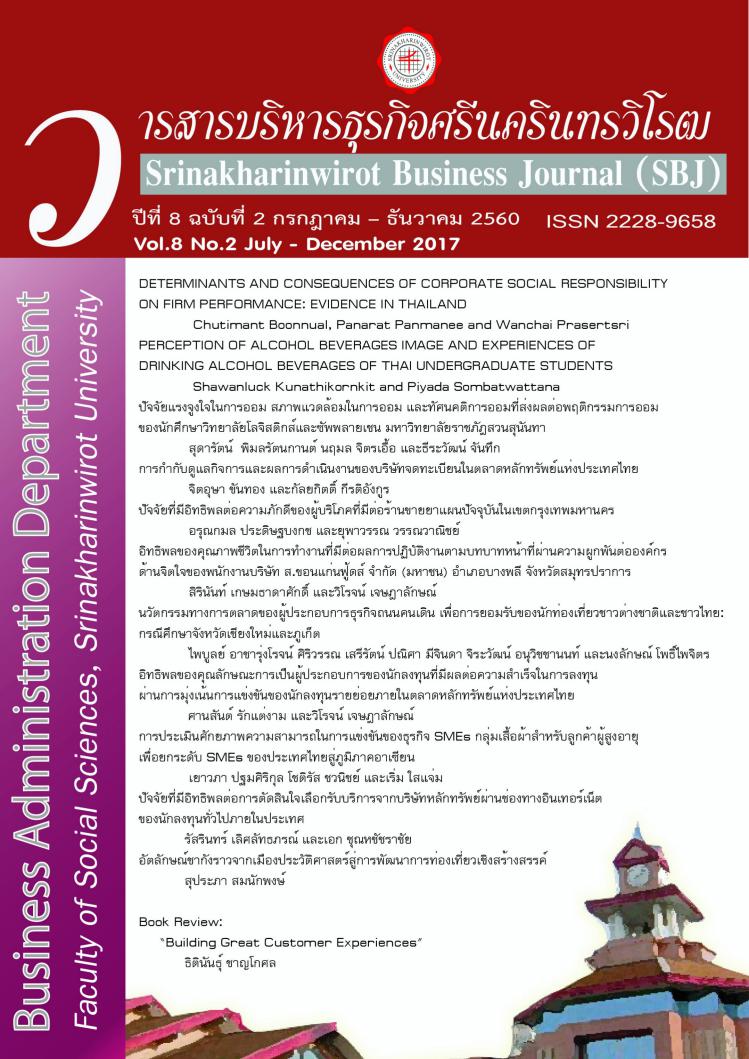การประเมินศักยภาพความสามารถในการแข่งขันของธุรกิจ SMEs กลุ่มเสื้อผ้าสำหรับลูกค้าผู้สูงอายุ เพื่อยกระดับ SMEs ของประเทศไทยสู่ภูมิภาคอาเซียน (COMPETITIVENESS EVALUATION OF SMES CLOTHING BUSINESS TO THE ELDERLY MARKET IN THAILAND AND ASEAN REGION)
Abstract
บทคัดย่อ การวิจัยนี้มีวัตถุประสงค์เพื่อ 1) วิเคราะห์จุดแข็ง จุดอ่อนโอกาส อุปสรรค ของธุรกิจ SMEs กลุ่มเสื้อผ้าของประเทศไทย 2) ประเมินศักยภาพความสามารถในการแข่งขันของธุรกิจ SMEs กลุ่มเสื้อผ้าสำหรับลูกค้าผู้สูงอายุในประเทศไทยสู่ภูมิภาคอาเซียน ใช้ระเบียบวิจัยแบบผสานวิธีด้วยการวิจัยเชิงปริมาณและการวิจัยเชิงคุณภาพ กลุ่มตัวอย่างที่ศึกษา คือ ผู้บริหารธุรกิจ SMEs กลุ่มเสื้อผ้าจำนวน 300 คน สุ่มตัวอย่างด้วยวิธีแบบชั้นภูมิและรวบรวมข้อมูลด้วยแบบสอบถามและแบบบันทึก ส่วนการวิจัยเชิงคุณภาพใช้การวิเคราะห์เอกสารและสัมภาษณ์เชิงลึกผู้ประกอบการธุรกิจเสื้อผ้าจำนวน 30 คน สถิติที่ใช้ในการวิเคราะห์ข้อมูล ได้แก่ สถิติเชิงพรรณนา ส่วนงานวิจัยเชิงคุณภาพใช้การวิเคราะห์เนื้อหา ผลการวิจัยพบว่า 1) ผลการวิเคราะห์จุดแข็ง จุดอ่อนโอกาส อุปสรรค ของธุรกิจเสื้อผ้า พบว่า ปัจจัยภายใน มีจุดแข็งในด้านปัจจัยนำเข้า/ การผลิต แต่มีจุดอ่อนในด้านกลยุทธ์การตลาด และอุตสาหกรรมเกี่ยวเนื่องและสนับสนุน ในขณะที่ปัจจัยภายนอก มีโอกาสในด้านปัจจัยอุปสงค์แต่ก็มีอุปสรรค ด้านปัจจัยนำเข้าเรื่องแรงงาน 2) ความสามารถในการแข่งขันของธุรกิจ SMEs กลุ่มเสื้อผ้าสำหรับลูกค้าผู้สูงอายุสู่ภูมิภาคอาเซียน พบว่า กลุ่มธุรกิจค้าส่งและค้าปลีกเสื้อผ้า มีคะแนนประเมินความสามารถในการแข่งขันสูงที่สุด ในขณะที่กลุ่มที่ออกแบบและมีแบรนด์เสื้อผ้าของตัวเองมีปัจจัยอุปสงค์สูงที่สุด (ร้อยละ 55) ธุรกิจเสื้อผ้าที่ส่งออกในอาเซียน ได้แก่ประเทศเวียดนามและมาเลเซีย ประเทศอินโดนีเซียและสิงคโปร์ และประเทศ สปป.ลาว ตามลำดับ มีความสามารถในการแข่งขันสู่ตลาดลูกค้าผู้สูงอายุเพื่อยกระดับ SMEs ของประเทศไทยในภูมิภาคอาเซียน คำสำคัญ :ความสามารถการแข่งขัน ธุรกิจเสื้อผ้า ผู้สูงอายุ SMEs ภูมิภาคอาเซียน Abstract This research aimed 1) to analyze strength weaknesses opportunities and threats of clothing industries in Thailand, and 2) to evaluate competitive ability and opportunities of clothing products for aging groups in order to enhance SMEs in Thailand to ASEAN region. Mixed methods have been employed in this quantitative research and the qualitative research. The research populations were 300 SMEs entrepreneur managers in clothing businesses. Stratifies random sampling was employed in the quantitative research component; the majority of key informants were 30 persons of the managers in clothing businesses. Data analysis and statistics used in this research were descriptive statistics. The content analysis was used in the qualitative research. The research findings were; 1) The results from the analysis of strengths and weaknesses, opportunities and threats of clothing industries were; the internal factor such as strength of import/ producing factors and weaknesses in marketing strategies and relating support industries. Meanwhile, the external factor such as demand factor seems positive but there is threat on import factor such as manpower. (2)The groups of wholesalers and clothing retailers earn the highest evaluation scores of competitive potentiality. The groups of designers owning their clothing brands earn highest demand (55%). The clothing exports in ASEAN were from Vietnam, Malaysia, Indonesia, Singapore, and Laos respectively earn the high evaluation scores of competitive potentiality. Key words: Competitiveness, Clothing Business, Elderly, SMEs, ASEANDownloads
Downloads
Published
How to Cite
Issue
Section
License
วารสารบริหารธุรกิจศรีนครินทรวิโรฒ ยินดีรับบทความวิจัยและบทความทางวิชาการด้านบริหารธุรกิจ เพื่อพิจารณาตีพิมพ์เผยแพร่ในวารสาร ซึ่งทัศนะและข้อคิดเห็นใดๆ ในวารสารฯ ถือเป็นความคิดเห็นและความรับผิดชอบโดยตรงของผู้เขียน มิใช่เป็นความคิดเห็นและความรับผิดชอบใดๆ ของคณะบริหารธุรกิจเพื่อสังคม มหาวิทยาลัยศรีนครินทรวิโรฒ ผู้ประสงค์จะนำบทความหรือบทวิจารณ์ใดๆ ไปเผยแพร่ จะต้องได้รับการอนุญาตจากวารสารเป็นลายลักษณ์อักษร ลิขสิทธิ์บทความที่เผยแพร่ทั้งหมดเป็นของวารสารบริหารธุรกิจศรีนครินทรวิโรฒ






